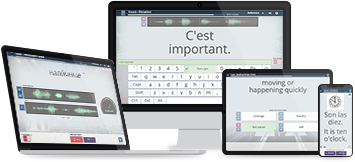Take It Step-By-Step Posted by Sean Young on Mar 1, 2012 in Archived Posts
In my previous post, I mentioned “Just like you can’t eat an entire meal in one bite, learning a language must be studied a little at a time“. That means taking your lessons and breaking them down into smaller, more manageable chunks. Even if you’re just learning from one small paragraph in 20 minutes, that’s fine as long as you get to understand it. You may also find yourself needing to break things down to the vocabulary level. Here’s an example. You want to make an apple pie and you’re out of apples. Don’t think you have to learn an entire lesson on shopping. So look for words that pertain to shopping for apples. Things like “apple”, “apples”, “pie”, “pie crust”, “How much is…?”, “How many…?”, and “I need…”, etc. Don’t make the list too long, just use what you think is needed for the situation at hand.
Now that you have the vocabulary needed, start putting the words together into meaningful sentences and practice saying them.
I need apples.
I need a pie crust.
How many apples do I need?
How much is it?
You may need to learn some very minor grammar points, but don’t make that your main focus for now. If you’re in the beginning stages of learning the language, reading the sentences directly from your notebook or mobile app is okay, since they are new constructions. Next, work on remembering them so you can use them whenever you need. This may sound complicated at this point, but let me assure you that it really is not. What you’re doing is taking steps toward communication that will allow you to make known your wishes and needs.
Learning to communicate this way may not seem so impressive. You might begin to think that it’s a lot of work, and you’ll never get to learn a language this way. Stop right there. Think of a skyscraper. How did it get there? Did it suddenly appear? Did a helicopter come along and drop it there? No, it went up one steel beam at a time, one glass pane at a time. It took thousands of small steps to make the big, impressive building you see in the picture. That’s what you’re doing with a language. You’re building it up one word at a time, held together with a grammar point here and there. Eventually all those words are building a whole language for you to use. Continue with this method to learn new vocabulary terms and use them to create new sentences – building the foundation for your skyscraper. This is very important in learning to communicate. You may still have a little trouble with grammar or maybe some slips in pronunciation, but your goal is to get your message across, so perfect grammar can wait a little while.
From what I’ve seen over the years, most of the language courses out there have the system backwards. First, they give you the conversation or a passage of text and instruct you look at it, read it over and listen to it before you get to the vocabulary listing. Some courses don’t give you a listing at all, but expect you to look up the words in the mini-dictionary at the end of the book. Ideally, they should be giving you the list of new words before the reading so you know what words to expect and look for.
For the first month or two, your learning is going to be one-sided. You’re building up your vocabulary and creating sentences for your linguistic skyscraper. Now you need to go out and start speaking with native speakers. This is the point where many students freeze and don’t say a word. Don’t let it happen to you. The most common fear is the possibility of not understanding what is being said to you in reply. As an exercise to help you get over that fear, listen to a radio station in the language you’re learning. Listen to the news, the songs, the ads. Watch some TV in your new language. (Use subtitles if you need, but don’t rely on them all the time.) See what you can understand from what you’re hearing. Take notes of any new vocabulary words or whatever you hear of interest. When I was learning Spanish, I watched some Pedro Infante movies on DVD with the subtitles on. And when they said something that sounded useful to learn, I wrote it down in my notebook. Lots of listening means that you will eventually distinguish the words and understand what you’re hearing.
When you do speak with a native speaker, you may find yourself hesitating to find the right word or your grammatical structures may not be the best – that’s a natural part of the learning process. Don’t let that discourage you. Do as you’ve been doing with your lessons. Think of the vocabulary that you’ve learned and put them together into sentences using what you know and before you know it, you’ll be starting off with one word and building up from them. You’ll get pretty far in your communications. Think of how much farther along you can get with adding on more steel beams and panes of glass.
I will not lie, you are going to have plenty of work to do. But, take it just one word at a time, one sentence at a time. Just keep building that skyscraper and you’ll find satisfaction with the end results.

Build vocabulary, practice pronunciation, and more with Transparent Language Online. Available anytime, anywhere, on any device.




Leave a comment: